There are two types of animation that a biped can perform: Freeform animation and Footstep animation. In this lesson, you'll use Freeform animation to make Dr. X do a series of deep knee bends. Freeform animation does not use footsteps. You manually set all the keys in a Freeform animation.
To get an idea of how your animation should turn out, view the preview animation, dr_x_kneebends.avi, in the folder \sceneassets\renderassets\.
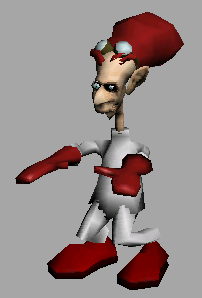
Dr. X doing his deep knee bend exercises.
 Open dr_x_03.max.
Open dr_x_03.max.
This scene contains Dr. X with properly adjusted envelopes.
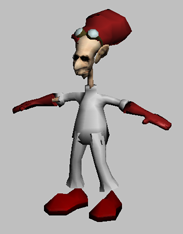
Since Dr. X is doing squats, his feet are not required to move. You'll plant his feet to keep them from moving throughout the exercise.
 Motion panel.
Motion panel.
 (Set Planted Key).
(Set Planted Key).
 (Opposite) to select DrX
Biped R Foot.
(Opposite) to select DrX
Biped R Foot.
 (Set Planted Key) to set
a key for the right foot.
(Set Planted Key) to set
a key for the right foot.
You'll start by animating the knee-bending motion. Dr. X will start the knee bend in his current stance with arms outstretched, and perform a total of four squats. When completed, he'll return to his original stance.
When the feet are planted, you animate the knees bending by moving the biped's center of mass up and down.
 (Body Vertical).
(Body Vertical).
 (Auto Key).
(Auto Key).
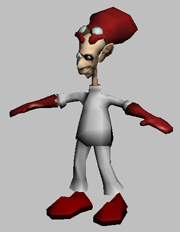
This places a key for the center of mass's body vertical track at frame 0.
 Move the COM down about
–0.25m on the Z-axis.
Move the COM down about
–0.25m on the Z-axis.
Watch the Coordinate display Z-field until it reaches about –0.25m and release the mouse button. A key is automatically created at frame 15. This is Dr. X's squatted pose.
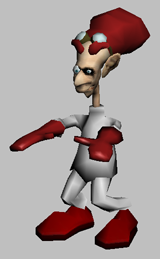
Copy and paste the standing posture:
The tools on this rollout enable you to quickly copy and paste keys from one frame to other frames. By default, the Posture option is selected. This option pastes keys from individual body parts.
 (Create Collections). Name
the Collection Dr. X poses.
(Create Collections). Name
the Collection Dr. X poses.
 (Copy Posture).
(Copy Posture).
 (Auto Key) is still on.
(Auto Key) is still on.
 (Paste Vertical).
(Paste Vertical).
 (Paste Posture).
(Paste Posture).
Dr. X stands up again. When you paste a posture with Auto Key turned on, a key is created at the current frame with the new posture. Here, a new key was created for the COM's Body Vertical track at frame 30.
Copy and paste the squatting posture:
 (Copy Posture). Rename the
posture Squatting.
(Copy Posture). Rename the
posture Squatting.
 (Paste Posture).
(Paste Posture).
Now that you've stored the two postures, you can easily paste them to other frames.
You have now created all the knee-bend motions for this animation. If you like, you can play the animation to see the motion.
 (Auto Key).
(Auto Key).
Now that the legs are set to bend, you'll rotate the arms and lock the upper body. As Dr. X dips down, his arms are going to swing forward, then back out to his sides as he rises. You'll also set two keys to lock the upper body to keep Dr. X facing forward.
 (Symmetrical) to select
the opposite upper arm.
(Symmetrical) to select
the opposite upper arm.
 (Set Key).
(Set Key).
This sets a key for the arms in their outstretched position.
 (Copy Posture). Name the
posture Arms Out.
(Copy Posture). Name the
posture Arms Out.
 (Auto Key).
(Auto Key).
 rotate the arms about –75 degrees
around the Z-axis.
rotate the arms about –75 degrees
around the Z-axis.
Look at the Z-field in the Coordinate display Z-field when rotating the arms. A key is added, and Dr. X's arms are in the forward position.
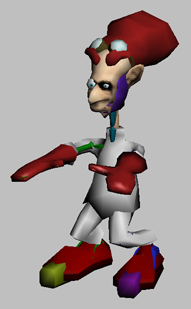
 (Auto Key).
(Auto Key).
 Modify panel, turn on the MeshSmooth
modifier by clicking the light bulb to turn it on.
Modify panel, turn on the MeshSmooth
modifier by clicking the light bulb to turn it on.
 Play the animation.
Play the animation.
When you're happy with the results of the animation, you want to save it so that in the future you can apply the motion to other bipeds in other scenes. When you save a motion, it is saved in the .bip file format, the native format for biped character movement.
 (Save File).
(Save File).
The motion is saved as a BIP file.
To learn more about freeform animation, see the tutorial Freeform Animation.